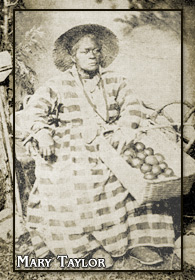Owen Sound's Black History

Quilt Codes
 Click to enlarge |
Flying Geese: A signal to follow the direction of the flying geese as they migrated north in the spring. Most slaves escaped during the spring; along the way, the flying geese could be used as a guide to find water, food and places to rest. The quilt maker had flexibility with this pattern as it could be used in any quilt. It could also be used as a compass where several patterns are used together. |
 Click to enlarge |
North Star: A signal with two messages--one to prepare to escape and the other to follow the North Star to freedom in Canada. North was the direction of traffic on the Underground Railroad. This signal was often used in conjunction with the song, “Follow the Drinking Gourd”, which contains a reference to the Big Dipper constellation. Two of the Big Dipper’s points lead to the North Star. |
 Click to enlarge |
Monkey Wrench: A signal to gather all the tools required for the fleeing slave’s journey, meaning the physical tools, as well as the mental and spiritual ones. |
 Click to enlarge |
Sailboat: A signal that either a body of water was nearby or that boats were available. |
 Click to enlarge |
Drunkard’s Path: A warning signal to take a zigzag route to elude pursuing slave hunters and their hounds that are in the area. A slave spotted travelling south, for instance, would not be suspected of escaping. |
 Click to enlarge |
Dresden Wheel: It is possible that the Dresden Plate could be a variation of the Wagon Wheel. Records indicate that the Dresden Plate quilt pattern did not emerge until the 1920s. |
 |
Wagon Wheel/Carpenter's Wheel: A signal to the slave to pack the items needed to travel by wagon or that could be used while travelling. It could also mean to pack the provisions necessary for survival, as if packing a wagon for a long journey, or to actually load the wagon in preparation for escape. Some records indicate this symbol meant a wagon with hidden compartments in which slaves could conceal themselves, would soon be embarking for the trip to freedom. |
 |
Wagon Wheel Variation: |
 |
Crossroads: A symbol referring to Cleveland, Ohio, which was the main crossroads with several routes to freedom. On a less literal level, the term “crossroads” also means reaching a turning point in one’s life, where a choice must be made and then carry on. |
 |
Bear's Paw: Follow a mountain trail, out of view, and then follow an actual bear’s trail which would lead to water and food. |
 |
Bow Tie (or Hourglass): A symbol indicating it was necessary to travel in disguise or to change from the clothing of a slave to those of a person of higher status. |
 |
Shoofly: A symbol that possibly identifies a person who can guide and help; a person who helped slaves escape along the Underground Railroad and who knew the codes. |
 |
Tumbling Blocks or Boxes: A symbol indicating it was time for slaves to pack up and go, that a conductor was in the area. |
 |
Broken Dishes: A symbol referring to a signal that involved broken crockery at some future landmark. |
 |
Britches: A symbol indicating the escaping slave needed to dress as a free person. |
 |
Rose Wreath: A symbol that indicated someone had died on the journey. It was an African tradition to leave floral wreaths on the graves of deceased. |
 |
Log Cabin: A symbol in a quilt or that could be drawn on the ground indicating it was necessary to seek shelter or that a person is safe to speak with. Some sources say it indicated a safe house along the Underground Railroad. |
 |
Double Wedding Ring: This pattern did not exist until after the American Civil War. However, the Double Irish Chain pattern did and is believed to have symbolized the chains of slavery. When a slave saw this quilt displayed, it meant the rings or shackles of slavery could be removed. When marrying, slaves did not exchange wedding rings; they “jumped the broom”. |

